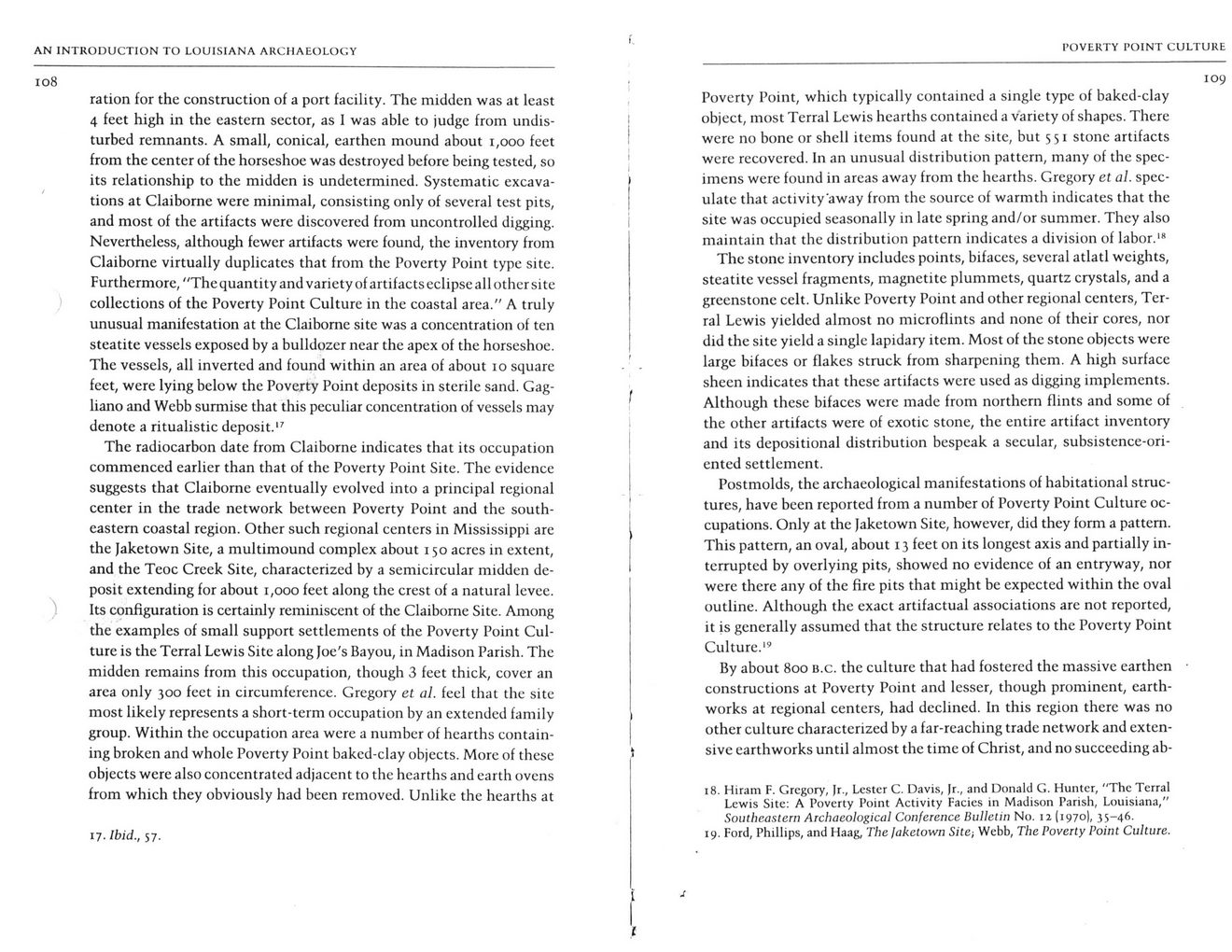This text was obtained via automated optical character recognition.
It has not been edited and may therefore contain several errors.
AN INTRODUCTION TO LOUISIANA ARCHAEOLOGY ration for the construction of a port facility. The midden was at least 4 feet high in the eastern sector, as I was able to judge from undisturbed remnants. A small, conical, earthen mound about 1,000 feet from the center of the horseshoe was destroyed before being tested, so its relationship to the midden is undetermined. Systematic excavations at Claiborne were minimal, consisting only of several test pits, and most of the artifacts were discovered from uncontrolled digging. Nevertheless, although fewer artifacts were found, the inventory from Claiborne virtually duplicates that from the Poverty Point type site. Furthermore, "The quantity and variety of artifacts eclipse all other site ) collections of the Poverty Point Culture in the coastal area." A truly unusual manifestation at the Claiborne site was a concentration of ten steatite vessels exposed by a bulldozer near the apex of the horseshoe. The vessels, all inverted and found within an area of about 10 square feet, were lying below the Poverty Point deposits in sterile sand. Gag-liano and Webb surmise that this peculiar concentration of vessels may denote a ritualistic deposit.17 The radiocarbon date from Claiborne indicates that its occupation commenced earlier than that of the Poverty Point Site. The evidence suggests that Claiborne eventually evolved into a principal regional center in the trade network between Poverty Point and the southeastern coastal region. Other such regional centers in Mississippi are the Jaketown Site, a multimound complex about 150 acres in extent, and the Teoc Creek Site, characterized by a semicircular midden deposit extending for about 1,000 feet along the crest of a natural levee. I Its configuration is certainly reminiscent of the Claiborne Site. Among the examples of small support settlements of the Poverty Point Culture is the Terral Lewis Site along Joe's Bayou, in Madison Parish. The midden remains from this occupation, though 3 feet thick, cover an area only 300 feet in circumference. Gregory et al. feel that the site most likely represents a short-term occupation by an extended family group. Within the occupation area were a number of hearths containing broken and whole Poverty Point baked-clay objects. More of these objects were also concentrated adjacent to the hearths and earth ovens from which they obviously had been removed. Unlike the hearths at 17. Ibid., 57. POVERTY POINT CULTURE Poverty Point, which typically contained a single type of baked-clay I object, most Terral Lewis hearths contained a variety of shapes. There I were no bone or shell items found at the site, but 551 stone artifacts ! were recovered. In an unusual distribution pattern, many of the spec- imens were found in areas away from the hearths. Gregory et al. speculate that activity away from the source of warmth indicates that the j site was occupied seasonally in late spring and/or summer. They also maintain that the distribution pattern indicates a division of labor.18 The stone inventory includes points, bifaces, several atlatl weights, steatite vessel fragments, magnetite plummets, quartz crystals, and a greenstone celt. Unlike Poverty Point and other regional centers, Terral Lewis yielded almost no microflints and none of their cores, nor did the site yield a single lapidary item. Most of the stone objects were ' large bifaces or flakes struck from sharpening them. A high surface sheen indicates that these artifacts were used as digging implements, f Although these bifaces were made from northern flints and some of I the other artifacts were of exotic stone, the entire artifact inventory | and its depositional distribution bespeak a secular, subsistence-ori- j ented settlement. i Postmolds, the archaeological manifestations of habitational struc- tures, have been reported from a number of Poverty Point Culture oc-y cupations. Only at the Jaketown Site, however, did they form a pattern. This pattern, an oval, about 13 feet on its longest axis and partially in-i terrupted by overlying pits, showed no evidence of an entryway, nor were there any of the fire pits that might be expected within the oval outline. Although the exact artifactual associations are not reported, it is generally assumed that the structure relates to the Poverty Point Culture.19 By about 800 B.C. the culture that had fostered the massive earthen constructions at Poverty Point and lesser, though prominent, earth-| works at regional centers, had declined. In this region there was no | other culture characterized by a far-reaching trade network and exten- i sive earthworks until almost the time of Christ, and no succeeding ab- 18. Hiram F. Gregory, Jr., Lester C. Davis, Jr., and Donald G. Hunter, "The Terral Lewis Site: A Poverty Point Activity Facies in Madison Parish, Louisiana,” Southeastern Archaeological Conference Bulletin No. 12 (1970), 35—46. 19. Ford, Phillips, and Haag, The faketown Site-, Webb, The Poverty Point Culture. i •' i

Poverty Point (Indian Culture) Poverty Point Culture - Louisiana Archeology Introduction (10)